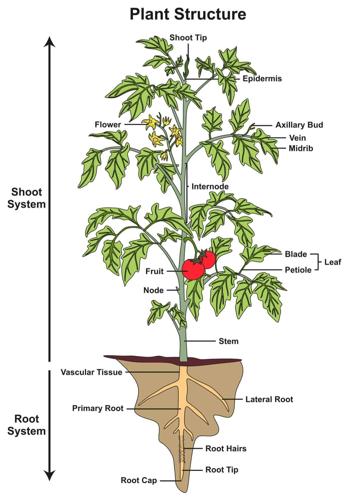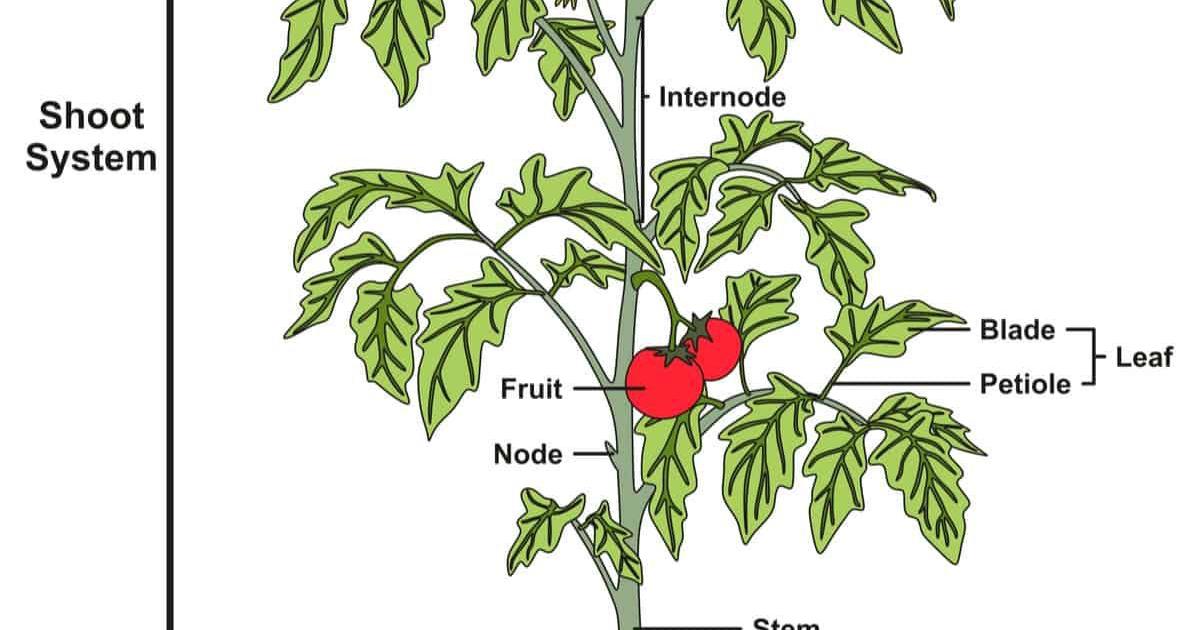Use the Terms That Describe Vegetative Parts of the Plant
A cutting of such a stem is buried in moist soil along with the bud. Wing plant any flat surfaced structure emerging from the side or summit of an organ.

Understanding The Parts Of A Plant Garden Swoknews Com
The stem bears small outgrowths called buds.

. Tubers are vegetative organs that may develop from stems or roots. Roots The roots anchor the plants and hold the stem upward. The petiole keeps the leaf blade exposed to wind and cools the leaf.
Striated marked by a series of lines grooves or ridges. The vegetative non-reproductive parts of the plant such as the leaves and the stems and the reproductive parts of the plant which include flowers and fruits. Tesselate marked by a pattern of polygons usually rectangles.
Plant propagation is the process of plant reproduction of a species or cultivar and it can be sexual or asexual. A new plant can be developed using the method of vegetative propagation. Term used to describe a condition in which the flower parts are attached above the ovary.
Biology relating to the parts of a plant that carry water salts and food from one part of the plant to another. Term used for petals and sepals that are not easily discernable from one another. These plants mature faster than and are sturdier than plants that develop from seeds.
A shoot system and a root system. The vegetative plant structures arising from the stem are known as rhizomes bulbs runners tubers etc. Stem tubers arise from rhizomes or runners that become swollen from storing nutrients.
It has undifferentiated cells which divide. While many plants reproduce by vegetative. Propagation without seeds is called vegetative reproduction.
The shoot system consists of two portions. This lab deals with characters of the vegetative parts of a plant - roots stems twigs and leaves. Root - anchor and absorbs underground positively gravitropic develop from radicle in seed.
Banana sweet potato cassava pineapple are some of the real-time vegetative propagation examples. Vegetative reproduction in plants is defined as a type of asexual reproduction wherein the vegetative parts like roots stem and leaves give rise to new plants. This mode of vegetative propagation or vegetative reproduction is associated with certain advantages and disadvantages.
It can happen through the use of vegetative parts of the plants such as leaves stems and roots to produce new plants or through growth from specialized vegetative plant parts. The plants propagated vegetatively are given below. Round in cross section.
Vegetative propagation produces genetically identical plants from a single parent plant. Vegetative plant parts used for asexual propagation. Note that only 1 plant would be involved in the process of vegetative propagation.
L621 Livestock nutrition Feeds and Feeding - Identification - classification of feeds - Terms used in expressing feed values - Computation of. A leaf consists of three main parts- petiole leaf base and lamina. New plants emerge out of swollen modified roots known as tubers.
Each part has a set of jobs to do to keep the plant healthy. In non-vascular plants the vegetative reproductive structures are gemmae and spores whereas in vascular plants the roots stems leaves and nodes are the vegetative propagation structures. The stem supports the plant above ground.
The leaf base is a protruding part of a leaf. The three main parts are. Up to 24 cash back Roots stems and leaves are vegetative organs of plants that could be used for asexual reproduction.
Certain plant parts such as stem or leaf cuttings will develop roots in growing medium and produce new plants with the same. Reproduction occurs through vegetative plant structures derived from roots stems and leaves. Potatoes and yams are examples of stem tubers.
There are certain natural as well as artificial methods for reproduction. Reticulate web-like or network-like. Vegetative Parts of the Plant.
In orders of three. The respective part of a plant will be useful to produce new plant species apart from its seeds. Leaves are derived from primordial buds produced by the apical meristem.
Vegetative propagation can take place from the stem in ginger and potatoes. Nevertheless these organs play an important role in the life cycle of plants. The shoot system generally grows above ground where it.
B describe digestion and digestive systems of cattle pig and poultry c define terms used to express feed values d compute a livestock ration e prepare balanced ration for various livestock f demonstrate a caring attitude towards livestock. Natural reproduction results in an offspring which will be a new. Runners grow horizontally above the ground.
The roots absorb water and minerals from the soil and anchor the plant in the ground. Vegetative structures include rhizomes runners bulbs tubers corms and buds. Plants growing above the ground that attach themselves to other plants without being a parasite.
This is the vegetative part of the lichen. ROOTS Tap root--main root enlarging and growing downward Fibrous roots--thin thread-like roots usually without a primary root present Adventitious root--root growing from something other than root tissue eg. Vegetative plant parts STUDY PLAY node part of a stem where a leaf is attached internode part of stem between two nodes bud embryonic shoot of a plant leaf scar scar left o the stem when a leaf falls vascular bundle scar spot within a leaf scar left by the vascular bundles when a leaf falls monocot plants having one seed leaf cereals corn grass.
Of reproduction characterized by asexual processes. Also we have learned about the meristem tissue in plants. The decaying vegetative layer covering a forest floor.
Not having or involving sex. Flow of cytoplasm with the cell. Mycotrophic - plants that rely on fungi to transfer nutrients to them from another plant.
Leaf - photosynthetic organ attached to stem has a bud at its base. The roots the leaves and the stem. Vegetative reproduction is applicable for plants only and is categorized under asexual.
Leaves are the most important part of a plant. This means that they do not produce sex cells or play a direct role in sexual reproduction. They contain chlorophyll that helps the plants to prepare their food using sunlight carbon dioxide and water.
The upper surface of a tuber produces a new plant shoot system stems and leaves while the bottom surface produces a root system. This tissue helps in the vegetative propagation. The buds are formed at the nodes of the runners.
Composed of vegetation or plants. The body of the lichen containing both algae and fungi. Vascular plants have two distinct organ systems.
Short hairs that are densely packed together.

Parts Of A Flower And Plant Do You Know Them All 7 Diagrams Flower Cell Leaf Stem Etc Home Stratosphere

Understanding The Parts Of A Plant Garden Swoknews Com

Parts Of A Plant Functions Of Plant Parts Dk Find Out

Parts Of Plant The Main Parts Of A Plant Include By Biology Experts Notes Medium
No comments for "Use the Terms That Describe Vegetative Parts of the Plant"
Post a Comment